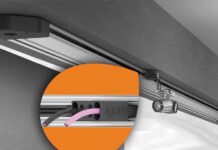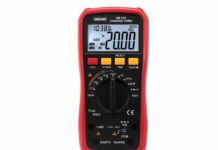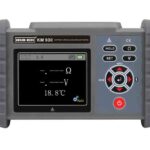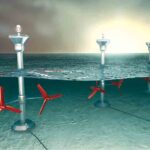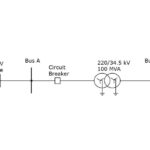
The XLPE Underground Cables (UG cables) have assumed greater importance in the present-day scenario, though, they are much costlier than the OH transmission lines, on the following counts:
- Aesthetic sense: As UG cables are not visible from outside, these provide a clean and aesthetic view of the city or town where UG cables are laid. This is one of the advantages to build clean India.
- RoW: They do not require RoW (Right of Way), unlike Overhead (OH) transmission lines.
- UG cables: They can be laid in the densely populated residential areas.
- Current carrying capability: Generally, an XLPE cable has capability of carrying large currents under normal (900C), emergency (1300C) or short circuit (2500C) conditions.
Brief description of the XLPE cables
XLPE is an abbreviation of ‘Cross linked Polyethylene’. Figure 1 shows the chemical formula of XLPE.


i. Conductor can be Milliken conductor or circular conductor of aluminium or copper.
ii. Corrugated aluminium sheath (shown in item no.6) facilitates sharp bending of the cable as well as can carry heavy earth fault currents.

i. Unlike aluminium sheath lead sheath is not capable of carrying high earth fault currents due to high fault levels, therefore copper-wire screen is provided…
Salient features of XLPE cables
Excellent electrical and physical properties: They have capability of carrying large currents. The XLPE cable has excellent resistance to thermal deformation – and its excellent aging process permits it to carry large current under normal (900C), emergency (1300C) or short circuit (2500C).
- Ease of installation: An XLPE cable withstands smaller radius bending and is lighter in weight, allowing for easy and reliable installation. Further, more, the splicing and terminating methods for XLPE cables are simpler in comparison with other kinds of cables.
- Free from height limitation and maintenance: An XLPE cable can be installed anywhere without special consideration of the route profile (height limitations) since it does not contain oil – and thus is free from failures due to oil migration in oil-filled cables.
- Life expectancy and general practice: Life expectancy of XLPE cable is > 40 years. Looking to expected load growth/demand and to avoid need for augmenting the cables from time to time, it is a general practice by the utilities to use higher conductor size.
Induced voltages on cable screens
- Electromagnetic voltage induction: The current flow in the inner conductor of the cable creates a magnetic field, which induces voltage on to the own cable screen as well as on to the screen of its neighbouring or surrounding cables.

If cable screens are connected forming a loop, by applying Ohm’s law, a current flows in that loop as a result of induced voltage – and the resistivity of the cable-screen material, thus produces additional power losses.
Induced voltage:
Ui =Xm.I.L
Where,
![]()
Mutual inductive reactance between core and the sheath
I = current in the cable conductor, in Amp
L = length of cable section in kms


Cable layout
Dependence of induced voltages
– Cable dimensions and cable lay-out
- Axial spacing between conductors (S).
- Cable sheath diameter (D).
- Length of the cable section (L).
- Network frequency (w=2πf).
- Short circuit current (worst case)
- Failure mode (Single phase, three phase)
Maximum Value of the induced voltage
- Limited by electrical properties of outer sheath
- Withstanding voltage 10kV DC for 1 min as per IEC
- Over voltage due to short circuits must be below this value
- Higher values to be limited by SVL
- Typical SVLs are of 3kV and 6kV nominal values
Note:
- Overload factor 1.36.
- Tolerance factor approx 1.1
- Residual voltage = approx 3 x nominal voltage of SVL.
Earthing or bonding methods and induced voltages
Both end bonding
Both ends of the cable sheath are connected to the system earth.
Advantage: With this method no induced voltages occur at the cable ends, that makes it most secure regarding safety aspects.
Disadvantages:
- Circulating currents would flow in the sheath as the loop between the two earthing points if closed through the ground.
- These circulating currents are proportional to the conductor currents resulting into reduction of the ampacity of the cable.


Single-end bonding
Sending end of the cable sheath is connected to the system earth. The other end is open thus standing voltage shall appear which is induced linearly along the cable length. In order to ensure safety requirements, the open end of the cable sheath has to be protected with surge arrester (Sheath Voltage Limiter).
The SVLs are basically a Metal Oxide Varistors (MOVs) surge arrester which deflect switching and atmospheric surges but must not trigger in the short circuits.

Earth Continuity Cable (ECC)
- In order to avoid potential rise in case of a failure, both earth points have to be connected additionally with an earth continuity cable.
- To avoid or minimise different earth potentials at both ends of the cable.
- To ensure correct operation of SVLs.


– Requirements:
i. Ability to carry the single-phase short circuit current;
ii. Must be placed in an induction-free manner to avoid difference in potential/circulating currents.

• Placement: between the power cables, 70% of cable axial distance apart from center cable.
• Transposition: ECC is transposed to the other side in the middle of the cable system to cancel out induced voltage.
• The ECC has to be insulated.

Cross bonding of sheaths of cables
Cross bonding of sheaths with SVL at bonding location
Please refer to figure 12A:
i. Generally used for long distance transfer of power.
ii. Minimum section of cables has to be 3 equal lengths.
iii. Generally equal length of cables is cross bonded.
iv. As could be seen from the figure 12A that there are 3 equal sections of the cables. The sheath of the cables of all the 3 phases are connected with each other in the cross-bonding system.
v. The sheaths of the cable of L1, L2 & L3 are earthed at the starting point of section 1, and at the end of the 3rd section they are again earthed.

Transposing of cables and cross bonding of sheaths thereof

Please refer to figure 12B:
i. For very long cables lengths or parallel circuits, in addition to cross bonding of the sheaths, the conductor of each phase may also be transposed as shown in the figure 12 B.
Cross bonding of the sheaths at the cable junction boxes
Cross bonding of sheaths done at the location of cable Jointing box through coaxial cable from each of the phase of the cables through coaxial cables through links with SVLs in the CB box as shown in the Figure 13A.
Cross bonding box: It can be used for installation in the floor or can be mounted on the walls as the case may be. (Figure 13B)


Short circuit considerations
- Since, it is a coaxial cable the reactance will be low and the impedance too will be low, however, if single core cable is used the impedance of the cable is higher than the coaxial cable.
- In case of short circuits heavy current shall flow and thus the transient voltage developed shall be low in the co-axial cable as compared to the single core cable.
- Due to low transient voltages the possibility of damage to the cable /cable -sheath is overruled.
- As per standards it should not be more than 10 metres.
- If more than 10 metres then complete engineering is to be done for reducing the Impedance of the co-axial cable.

Selection of proper SVL
The SVLs are very important equipment used in single end bonding of screen or sheath as well as in the cross-bonding schemes. Once the over voltages are known on each cable section in power frequency mode (normal operation and short circuit) then appropriate SLV is selected as follows:
- The limiter should be suitable for continuous operation with an applied voltage equal to the shield or sheath standing voltage under either normal or emergency loads.
- The surge voltage limiter must be designed to dissipate the energy associated with the transient over voltages impressed upon.
- The maximum continuous operating voltage Uc of the SVL must always be higher than the maximum induced voltage at the cable section during short circuit (this is extremely important failing which SVL will be destroyed).
Note: It is recommended to use 3kV SVL for 66kV cables and 6kV SVL for 132 and above. For example, if the Uc is (say) 4kV then SVL to be used should be of 6kV.
- The residual voltage Ures of SVL must be lower than the impulse withstand- voltage of the cable outer jacket and joint outer protections, typically considering the recommended15-20% safety margin.
Note: The function of SVL is to protect the cable outer jacket if residual voltage of SVL is more than the cable outer jacket, the outer jacket will fail in case of the fault.

Er.K. K. Murty possesses B.E.(Hons) Elec. Engg. He is an FIE, CE (India), Member-CGRE. He is a former Chief Engineer & HOD (Testing & Commun.), M.P. Power Transmission Co. Ltd. Jabalpur. He has worked as an Advisor (Testing) in SOUTHCO, Berhampur, Odisha (A DISCOM in Odisha (ADAG). He has also worked as Metering Consultant to M. P. Electricity Regulatory Commission, Bhopal. He was a Course Director for the Graduate Electrical Engineering Trainees, in the Training Institute of MPPTCL, Jabalpur. He was empanelled as an Expert Professional on the panel of CPRI, Bangalore and carried out third party inspection of power equipment on behalf of CPRI, Bangalore. Presently, he renders his services as a Sr. Visiting / Guest Faculty, for the in-house Training Institutions of the MPPTCL, Jabalpur and the M.P. East Zone, DISCOM, Jabalpur. He authored a book titled, “Compendium of Articles on EHV Substations & Protections for Budding and Practicing Engineers of Transmission Utilities.”



